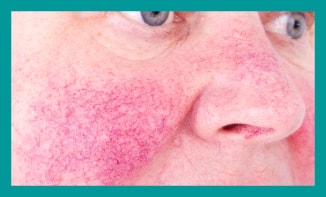Rosacea Treatment
 Guardian featured Harley Street IBS & Skin Clinic addresses the underlying issues, not just the symptoms in Rosacea treatment.
Guardian featured Harley Street IBS & Skin Clinic addresses the underlying issues, not just the symptoms in Rosacea treatment.
Rosacea Treatment: Rosacea is a common skin condition. It often begins with a tendency to blush or flush more easily than other people.
The redness can slowly spread beyond the nose and cheeks to the forehead and chin. Even the ears, chest, and back can be red all the time.
Rosacea can cause more than redness. There are so many signs and symptoms that rosacea has four subtypes:
- Erythematotelangiectatic rosacea: Redness, flushing, visible blood vessels.
- Papulopustular rosacea: Redness, swelling, and acne-like breakouts.
- Phymatous rosacea: Skin thickens and has a bumpy texture.
- Ocular rosacea: Eyes red and irritated, eyelids can be swollen, and person may have what looks like a sty.
Women are slightly more likely than men to get rosacea. Women, however, are not as likely as men to get severe rosacea. Some people are more likely to get rosacea, but anyone can get this skin condition. People of all colours get rosacea. Children get rosacea.
Causes
Mainstream medicine is still trying to find out what causes rosacea. By studying rosacea, scientists have found what they feel are some important clues:
- Rosacea runs in families. Many people who get rosacea have family members who have rosacea. It is possible that people inherit genes for rosacea.
- The immune system may play a role. Scientists found that most people with acne-like rosacea react to a bacterium Bacillus oleronius. This reaction causes their immune system to overreact. Scientists still do not know whether this can cause rosacea.
- A bug that causes infections in the intestines may play a role. This bug, H pylori, is common in people who have rosacea. Scientists cannot prove that H pylori can cause rosacea. Many people who do not have rosacea have an H pylori infection.
- A protein that normally protects the skin from infection, cathelicidin, may cause the redness and swelling. How the body processes this protein may determine whether a person gets rosacea.
Mainstream Medical Treatment
According to the mainstream medical community, the cause of rosacea is unknown and there is no cure for the condition. In contrast, functional practitioners take the skin symptoms into account, but also use them as signals to uncover deeper issues going on beneath the surface.
As with most health conditions, there are multiple underlying factors in rosacea rather than just one cause. Functional medicine tests are used to understand the root causes of the skin issues. Then a tailored plan is created utilising non pharmaceutical medicine in order to address the root issues and allow the skin to heal. Treatment for rosacea is based on the test results in order to meet each patient’s unique needs. We do not use a one size fits all approach.
We also address the gut issues, which are often associated with this condition.
References:
If you would like to book an appointment
Contact Deborah’s Medical Secretary for an appointment